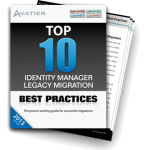I confess that I’ve been around the Tech industry long enough (i.e., the 1990’s) to recall when "working from home" was not an easy thing to do. For most companies back then, when an employee wanted to work from home he or she usually did not have a way to connect to their company’s server. In most cases they would have to do their work on their home computer — if they had one — save it to a floppy disk (remember those?) and then upload it to the office computer the next work day.
Even on the rare occasion when they did have a way to connect to the office, it was probably via a dedicated dial-up connection that only highly sophisticated companies could manage.
At any rate, the security for remote access was relatively simple — because few if any employees could do it, nobody worried about it.
Today, however, the number of employees working remotely has exploded and continues to increase exponentially. With the expansion has come the increasing amount of data being trusted to the "Cloud". Of course, more data being stored in and accessed from the cloud means a greater need for cyber security management and it also heightens the value of Identity Access Management (IAM).
Managing employees that access applications and devices is an overwhelming task that has historically fallen upon the shoulders of already overburdened IT and helpdesk professionals. Overseeing it in-house is difficult enough, but to add cloud-based applications further complicates the challenge. However, moving IAM to users who actually understand the access frees IT departments to focus on other business-critical issues in the organization.
This also makes for a more effective application of IAM. Any avid sports fan knows that if you don’t follow a team closely you "need a scorecard to tell apart the players". Whereas IT Departments need "scorecards" to know which employees are authorized to access applications and data via the cloud, managers and application owners do not because they are familiar with the information and people who should access it.
However, in order to ensure managers can be effective with applying identity access management solutions, IAM needs to be as flexible and accessible as possible. And what is more flexible and accessible these days than the cloud?
This is a point championed recently by IT security writer Sue Poremba in a post on the Cloud Centrics Blog. She points out that. "Moving IAM to the cloud provides a management solution that is flexible, scalable and easily manageable from anywhere…" She also notes that placing Identity and Access Management solutions in the cloud significantly reduces access provisioning complexity, historically a sore spot for such solutions.
There are a number of advantages to establishing an identity access management program regardless of the target identity concerns (cloud or not):
*Ownership: limits identity and access governance risk by placing trusted group accountability decisions in the hands of managers rather than IT; enables users to set primary and secondary owners and makes managers responsible for group renewals and access management.
*Solution Indexing: allows managers to select and complete tasks like user provisioning, asset allocation, application authorization, and self-service password reset easily
*Self-Service Requests: eliminates delays in user account provisioning resources by entrusting Identity and Access Management to the appropriate manager
*Group Expiration: eliminates group sprawl by setting group expiration dates, automatic group management and notifications alerting group owners before erasing groups
*Group Addition: allows the business to request the addition of groups to systems and automates the ability to create groups and email distribution lists through self-service group management.
So before your business allows its employees to work remotely — from home, on the road or "up in the clouds" on a plane — you should be sure that your identity access management solution addresses both cloud and localized identity management and IT cyber security concerns in a way that allows for managers and other application owners to own the approval process.
Watch the Avatier Identity Analyzer Product Introduction video:
Get the Top 10 Identity Manager Migration Best Practices Workbook
 Start your migration from legacy software with the Top 10 Identity Manager Migration Best Practices Workbook. Use this workbook to think through your information security risk before you transition to next generation identity manager software.
Start your migration from legacy software with the Top 10 Identity Manager Migration Best Practices Workbook. Use this workbook to think through your information security risk before you transition to next generation identity manager software.




